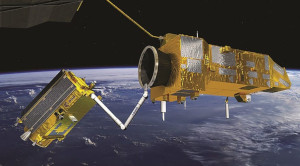Active space debris removal trajectory design

The space close to our planet is getting more and more polluted. Orbiting debris are posing an increasing threat to operational orbits and the cascading effect, known as Kessler syndrome, may result in a future where the risk of orbiting our planet at some altitudes will be unacceptable. According to NASA scientists [1] the Low-Earth-Orbit region (LEO) has already reached a sufficiently high debris density to trigger such a cascading effect. Its debris population will thus keep increasing even if no further launches will be made. Removing well chosen pieces of debris from a given contaminated orbital environment may then be the only option to continue exploiting near-Earth space. Previous works have considered, at a preliminary stage, the design of an Active space Debris Removal (ADR) mission. A spacecraft would be launched and rendezvous with the selected debris object to then de-orbit it by means of robotic manipulators, electrodynamic tethers, ion thrusters or some other technology. The same spacecraft would then move to the next piece of debris. Choosing the sequence of debris to be removed is a crucial part of the design for such missions.
The aim of this project is to find the optimal debris encounter sequence given a limited amount of fuel by creating and solving well defined instances of optimisation problems.
Modeling
It has been already noted recently how the debris selection problem bears strong similarities to the Travelling Salesman Problem (TSP) [2,3]. One of the main differences is that debris, unlike cities, are moving and the value of a visiting sequence thus depends on the visiting schedule (i.e. the exact epochs of rendezvous and departure from each debris). This makes the combinatorial problem of finding the optimal sequence of rendezvoused debris pieces dynamic. In this project we introduce two new variants of the TSP classic formulation: the TSP city selection (TSP-CS) and the dynamic TSP city selection (TSP-DCS). We show how they relate to the design of ADR missions, and more generally to problems where the travelling salesman needs to select which cities to visit within a given budget and in a scenario where the cities are moving. Further each debris piece is of a certain size and mass. These characteristics determine its probability to trigger a cascading effect and its overall hazardousness. Thus the cities in our TSP models are weighted.
Methodology
While in previous works on ADR mission designs only tens could be considered, we consider debris clouds of several hundred pieces. The debris sets we are analyzing originate from the Iridum 33 - Cosmos 2251 satellite collision and from the Fengyun-1C Chinese anti-satellite missile test. For solving the combinatorial problem of finding an optimal removal sequence we are using a genetic algorithm. Each selected debris piece is rendezvous for a certain time span. This rendezvous length gives a measure on how dynamic our problem is. We found that the performance of the genetic operator highly depends on this measure.
Data
We show a brief presentation that was made for the GECCO best paper award nomination we had the honour to receive for the work on this topic.
We provide data to initialize a static TSP-CS. We give, for each of the debris clouds Iridium 33, Cosmos 2251 and Fengyun-1C, a weight matrix. Each entry states the transfer costs between a certain pair of debris pieces. Further we give the cross section areas of each piece. This areas can be used to weight the debris pieces importance. Download the files.
References
- Liou, J-C., Johnson, N., Instability of the present leo satellite populations. Advances in SpaceResearch, 41(7):1046-1053, 2008.
- Braun, V., Lupken, A., Flegel, S., Gelhaus, J., Mockel, M., Kebschull, C., Wiedemann, C., Vorsmann, R., Active debris removal of multiple priority targets, Advances in Space Research, 51(9):1638-1648, 2013.
- Cerf, M., Multiple space debris collecting mission debris selection and trajectory optimization, Journal of Optimization Theory and Applications, 156(3):761-796, 2013.